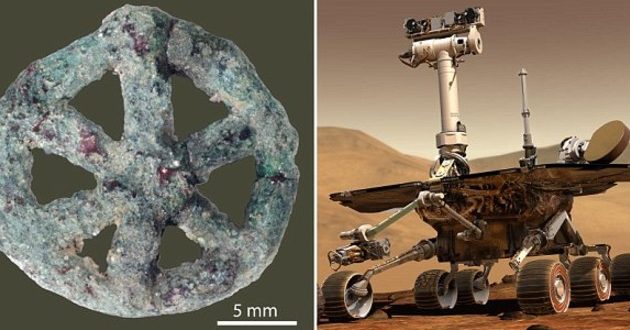An ancient amulet has been shown to be the oldest known example of a metalwork technique still used by Nasa.
The 6,000-year-old amulet, originally discovered in the Neolithic village of Mehragarh, Pakistan, is thought to be the earliest example of lost-wax casting – a method for making duplicate metal objects.
Mathieu Thoury from the French Synchrotron and colleagues devised a new, non-intrusive way to uncover minute details in metal and, using their “photoluminescence” technique, confirmed the wagon-wheel-shaped Mehrgarh amulet is the oldest known object cast in the “lost wax” method.
They published their findings in Nature Communications.
Analysing ancient artefacts can be tricky. Not only are they often highly corroded, but they can be made of loads of different materials, each of which requires a different set of instruments to visualise.
Thoury and his colleagues thought there was a better way. They developed what’s known as full-field photoluminescence imaging.
Light shone on a sample is absorbed. But that energy causes the sample to emit wavelengths of its own.
Those re-emitted wavelengths can tell researchers about the crystalline structure of the sample as well as its atomic makeup.
To see how it worked, they tried their full-field photoluminescence technique on the copper, two-centimetre-wide Mehrgarh amulet. It was manufactured in the early Neolithic period and uncovered on the Kacchi Plain of Balochistan, Pakistan.
It was thought to be the oldest known example of a casting technique known as lost-wax casting.
The process is fairly straightforward: make your object from a material with a very low melting point, such as beeswax, then encase it in clay to form a mould.
The mould is heated and hardens, but this also allows the beeswax to melt and run out, leaving a cavity in the clay. Metal, such as copper, is then poured into the mould, and once it was cool, the mould is smashed open to reveal the object inside.
To see if the Mehrgarh amulet was made in this manner, the researchers had to examine its crystal structure. Did it have solder-points where the “spokes” meet the “wheel”? Was it hammered into shape after being cast? And was it produced from pure copper or an alloy?
X-rays showed the Mehrgarh amulet was corroded all the way through, making analysis difficult – until Thoury and colleagues’ new technique.
They found the amulet was, indeed, cast as one whole piece. There were no soldered parts, nor were there crystal deformations that might signal hammering.
Only trace amounts of gold, mercury, iron and silver were found in the amulet, suggesting the copper poured into the lost wax mould was exceptionally pure.
The technique, the researchers write, isn’t limited to archaeology – it can be used in a huge array of fields such as geophysics, environmental science and engineering.
Agencies/Canadajournal
 Canada Journal – News of the World Articles and videos to bring you the biggest Canadian news stories from across the country every day
Canada Journal – News of the World Articles and videos to bring you the biggest Canadian news stories from across the country every day



